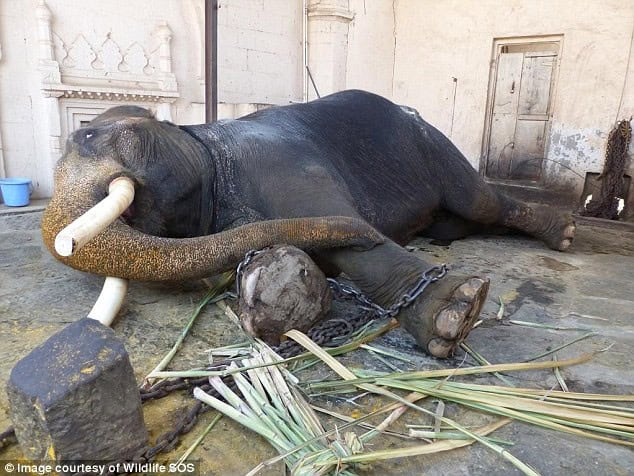A year can change everything. In December 2015, Suraj, a 45-year-old Asian elephant whose name means “Sunny,” was discovered living in appalling conditions. For over 20 years, he had been confined to a dark, 12-foot-square room, tethered by heavy chains in a temple in Maharashtra, India.
Emaciated, with a broken tail and missing an ear, Suraj’s only role was to serve as a photo prop for locals and tourists.

His bleak life involved only one annual outing, where he was paraded in a religious procession. Tragically, during one of these events, the stress of the crowds drove him to panic, leading to a deadly stampede.
Following this, Suraj was condemned to remain chained until he died, suffering from starvation, dehydration, and depression.

Thankfully, his fate took a turn when Wildlife SOS India intervened. With the help of donations from Mail on Sunday readers—40,000 of whom shared the original story about the cruelty faced by temple elephants—an ambitious rescue mission was launched.
On December 21, 2015, a 90-member team arrived at 2 a.m. to free Suraj, despite resistance from a crowd of 200 who wanted to keep him.
Incredibly, Suraj slept through the chaos, unaware that his ordeal was ending. Suraj calmly stepped onto the rescue vehicle as his caretakers protested, marking the beginning of his new life.

A year later, Suraj thrives at Wildlife SOS’s Elephant Conservation and Care Centre in Mathura, near New Delhi.
His story garnered widespread attention, with Time magazine naming him one of the Most Influential Animals 2016.
He now shares the spotlight with Raju, another elephant who made headlines after being freed from chains following more than 50 years of captivity.
However, Suraj’s recovery has not been without challenges. Years of poor nutrition left him with digestive issues, numerous wounds, and severe foot problems, including cracked toenails, swollen footpads, and an abscess.
The psychological trauma from his years of captivity also persisted. On several occasions, Suraj panicked after lying down, too weak to stand without help from a crane.
Special support structures have since been built to assist him, and during his weakest moments, he was put on an intravenous drip to stay hydrated.
Now, Suraj enjoys a healthier diet of green fodder, fruits, and vegetables. His favorite treat is peanuts, which he receives as a reward during treatment sessions.
Discovering the pool at the center was another breakthrough for him, as the sensation of weightlessness in the water became a source of joy.
But above all, Suraj loves his walks—after years of confinement, he relishes the freedom to explore, forage, and experience the world around him.
While Suraj is working to move on from his two decades as a “living statue,” the scars of his past remain. As the saying goes, elephants never forget, but at least now, Suraj is creating new, happier memories.
